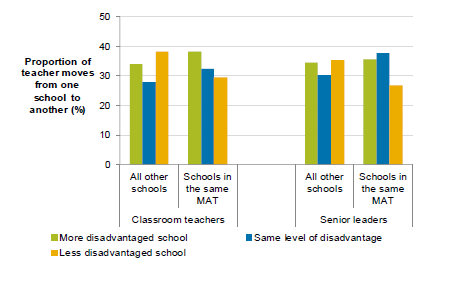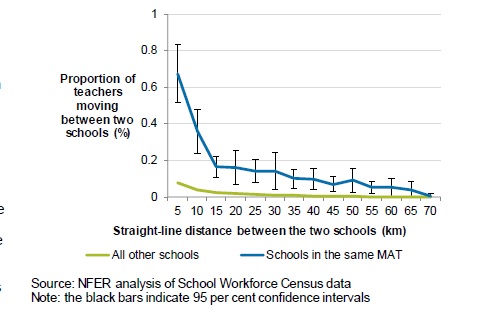Multi-academy trusts are dodging the recruitment crisis by parachuting teachers into schools that would normally struggle to hire, a new study has found.
The National Foundation for Educational Research (NFER) has today published its latest multi-academy trust (MAT) teacher retention research.

The study, based on School Workforce Census data from 2010-15, found that movement of staff between schools in the same trust is more than ten times higher than movement between schools not in the same academy trust.
Plus, while teachers are more likely to move to a school with a more advantaged intake, when looking just at moves between schools in the same MAT, teachers were more likely to move to a school with a disadvantaged intake (38 per cent), than to a more advantaged one (30 per cent).
Previous studies have found that schools serving lower income communities face greater recruitment difficulties in hiring staff.
The report claims this means MATs have “internal teacher labour markets” that are “somewhat distinct from the teacher labour market in local area”.
“Given the flexibility and strategic oversight that MAT leaders have over staff deployment across their schools, MATs may offer an alternative and potentially effective mechanism of deploying staff to schools in challenging areas that struggle to recruit and retain staff.”
The report stated the moves could be down to opportunities for career progression across different schools, with trusts developing a “leadership pipeline from within”.
Such an approach has been championed by the government, including former education secretary Nicky Morgan who said flexible staff deployment would “give a clear path to career progression that will keep [teachers and leaders] engaged rather than looking for opportunities elsewhere”.
However the report found, that teachers were much more likely to move between schools based in geographic clusters (see image below left).
This finding backs up previous research by the Department for Education showing that around 70 per cent of all teachers that moved school between 2010 and 2015 moved to a job within 25 kilometres of their previous one.
The NFER study found that larger trusts with geographically clustered schools have the greatest amount of internal school-to-school movement.
The data, however, doesn’t capture informal working arrangements – only permanent moves and secondments.
Jack Worth, report author and a senior economist at NFER said: “MATs are an important and growing feature of the school landscape in England. As the legal employers of all staff in their schools, MAT leaders have the opportunity to redeploy teachers and senior leaders to where they are most needed in their academy trust.
“Our analysis shows that they are making use of these opportunities by encouraging teachers to move within the MAT. It is particularly encouraging to find that teachers are tending to move to schools with more disadvantaged intakes, as these are the schools that tend to find it hardest to hire staff.”



Moving teachers between schools seems sensible as long as the teachers concerned agree willingly and the academies are geographically close. But there are questions: who would pay travelling if the new job is further away? what if the teacher had to move house? could a teacher refuse or would that be career suicide?
Hmmmm, you’re getting perilously close to saying there might be some benefits to the MAT model. Good job you pulled back by pointing out some theoretical problems, all of which probably wouldn’t be problems in practice because they would be explicitly covered in the employment contracts teachers would sign with the MAT. If the MAT wanted to be able to deploy teachers to any schools in their MAT without needing their consent it would have to be set out. Whatever school a teacher is planning to join they should read their contract of employment (whether it is from a MAT or anyone else), and if they don’t like the proposed terms they shouldn’t become an employee of that entity.
All in all this seems like a very positive story on how MATs help deal with getting teachers into disadvantaged schools. This is certainly how the author of the report sees it, using words like “particularly encouraging”. I wonder if this will be acknowledged …
Mark – LAs may also be able to shift teachers around like this because LAs employ the teachers not the schools (although school governing bodies appoint them). As you say, the contract is all-important. If a contract ties a teacher to a particular school then it would be difficult for an employer (LA or academy trust) to move that teacher.
It’s a little disingenuous to say prospective employees should check their contracts and refuse employment if not satisfied. People need an income and might not be in a position to refuse an offer.
But the fact is they don’t, do they?
To repeat what the report says: “movement of staff between schools in the same trust is more than ten times higher than movement between schools not in the same academy trust”.
TEN TIMES higher. That’s an enormous difference between LAs and MATs.
Go on, say that there may be some areas where MATs do better than local authorities. I dare you!!!